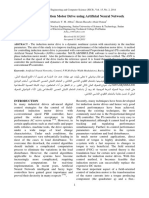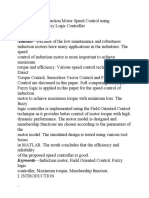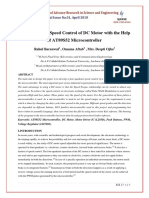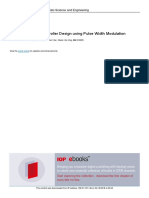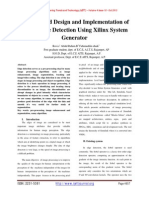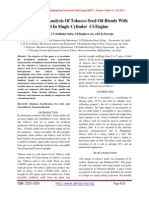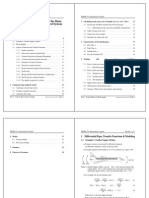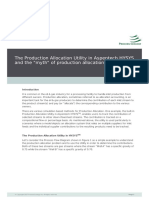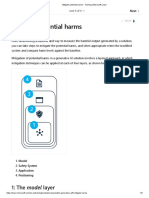Neural Network Based Closed Loop Speed Control of DC Motor Using Arduino Uno.
Uploaded by
seventhsensegroupNeural Network Based Closed Loop Speed Control of DC Motor Using Arduino Uno.
Uploaded by
seventhsensegroupInternational Journal of Engineering Trends and Technology- Volume4Issue2- 2013
Neural Network based Closed loop Speed Control of DC Motor using Arduino Uno.
Neerparaj Rai#1, Bijay Rai#2
Electrical and Electronics Engineering Department, Sikkim Manipal University Sikkim, India
Abstract This paper presents the design and implementation of Arduino Uno based DC motor speed control system using Multilayer Neural Network controller and PID controller. A model reference structure is developed using PID control to obtain the neural controller .The artificial neural network is trained by Levenberg-Marquardt back propagation algorithm. Feed forward neural network with two hidden neurons and one output neuron is used. Speed of the dc motor is controlled by varying the duty cycle of the pwm signal which is fed to the gate of the mosfet irf 640. Simulation and practical results are presented to demonstrate the effectiveness and advantage of the control system of DC motor with ANNs in comparison with the conventional control scheme in Matlab/Simulink R2009b. PID algorithm and ANN controller is implemented in Arduino Uno because of its easy compatibility and portability. KeywordsDC motor, Arduino, Artificial neural networks, Atmega 168. Introduction
methods mentioned before: model reference direct inverse control and indirect adaptive control. The proposed method uses Levenberg-Marquardt back-propagation training algorithm and is desired to track a reference model. The method can be considered as a direct controller design. Although it does not require any knowledge of the system dynamics, it requires the sensitivity of the controlled system. This paper describes a method of implanting a fully connected multi-layer neural network with multi-layer connections on a very inexpensive Atmega 168 microcontroller I. DC MOTOR CONTROL WITH ANN A dc motor is widely used for control purposes because of its stability and straight forward characteristics. For effective analytical purposes, mathematical models are indispensable. The separately excited dc motor is the simplest of all dc motors and it is the one most commonly found in industrial applications. A. Mathematical model of DC motor: The separately excited DC motor is described by the following equations: KFp(t) = Raia(t) La[dia(t)/dt] + Vt(t) (1) KFia (t) = J[dp(t)/dt] + Bp (t) + TL(t) (2) where, p(t) - rotor speed (rad/s) Vt (t) - terminal voltage (V) ia(t) - armature current (A) TL(t) - load torque (Nm) J - rotor inertia (Nm) KF - torque & back emf constant (Nm/A) B - viscous friction coefficient (Nms) Ra - armature resistance () La - armature inductance (H)
DC motors are one of the most widely prime movers in industry today. There are many ways for DC motor speed control such as Proportional-Integral-Derivative (PID) control, state space control, digital PID control and others. However, Artificial Neural Networks (ANN) have emerged as a tool for difficult control problems of unknown non-linear systems. Neural networks are used for modelling and control of complex physical systems because of their ability to handle complex input output mapping without detailed analytical models of the systems.
There are several control strategies for neural networks such as: 1) Feed forward control, 2) Direct inverse control (extracting inverse dynamics), 3) Indirect adaptive control method based on NN identification, 4) direct adaptive control with guarantied stability, 5) Feedback linearization, 6) Predictive control [1]. In the direct inverse control method, a MNN is trained by specialized back-propagation algorithm [2]. From these equations mathematical model of the DC motor This method has attracted much attention in recent years can be created. The model is presented in Fig1. Where, because it is intuitive, and simple to be implemented [3]. Ta -Time constant of motor armature circuit, Ta=La/Ra(s) However, the plant to be controlled may not have a unique or and, stable inverse, which is the drawback of direct inverse Tm Mechanical time constant of the motor Tm=J/B (s). dynamics method. In this study, a control strategy is proposed for the real time control of single-input single-output linear and nonlinear systems. The proposed method resembles previous two
ISSN: 2231-5381
http://www.internationaljournalssrg.org
Page 137
International Journal of Engineering Trends and Technology- Volume4Issue2- 2013
y(k+1)=f[y(k), y(k-1), .,y(k-na), u(k), u(k-1), .,u(k-nb)] (3) This process is called as one step ahead prediction and the structure is called Time Delayed Neural network. Equation (3) can be easily implemented [6]. In this paper, the ANN controller is time delayed neural network. The proposed method can be used as adaptive or non-adaptive controller. If learning process continues, the controller will be an adaptive controller. In non-adaptive case, learning process is executed as offline or for a certain period of time. In designing and training an ANN to emulate a function, the only fixed parameters are the number of inputs and outputs of the ANN, which are based on the input/output variables of the function. The choice of the number of hidden neurons is based on experience. It is also widely accepted that maximum of two hidden layers are sufficient to learn any arbitrary non-linearity. The back-propagation training technique adjusts the weights and bias in all connecting links in the nodes so that the difference between the actual output and target output are minimized for all given training patterns.[2] The diagram of neural network used in the control of DC motor is shown in figure 3. The time delayed neural network is a multilayer neural network and has four inputs. The MNN has one hidden layers, which consist of 2 neurons with tan sigmoid activation function. The output layer of the NN has only one neuron with pure linear activation function.
Fig. 1 The mathematical model of separately excited dc motor.
B. PI control method: Firstly, for controlling the speed of DC motor PI control strategy is applied. The block diagram for the PI control is developed in Matlab/Simulink and the transfer function for the PI control is obtained using Ziegler-Nicholas method.
Fig. 2 Simulink model for PI controlled dc motor.
There are different methods to synthesize control systems of DC motor, but for a comparison with method using ANNs, a conventional PI control of DC motor is used. The plant obtained in fig2 is used as the reference model to obtain the input and target samples. C. The control system of DC motor using ANNs: A neural network comprises simple elements operating in parallel. In fact, it is a massively parallel distributed processor that stores experiential knowledge and makes it available for use when needed. In using neural networks for system identification, training data can be obtained by observing the input-output behaviour of a plant. If previous values of the input and output are present, the future value can be predicted as:
Fig. 3 ANN control schema for dc motor.
The network is trained for 500 second applying a 0.2 Hz square wave to the reference model. The load was 10gm-cm during training. The architecture of the proposed ANN controller in MATLAB Simulink is shown in Fig. 4.
ISSN: 2231-5381
http://www.internationaljournalssrg.org
Page 138
International Journal of Engineering Trends and Technology- Volume4Issue2- 2013
The step pulse response of dc motor with trained neural controller at 10gm-cm load is given in Fig. 5. The load is increased to 30 gm-cm at 3sec, but the motor reverts back to the set speed of 120 rad/sec within 0.2 sec. The response of the motor to a sinusoidal input signal is also given in Fig. 6.
Fig. 4 Architecture of the proposed ANN controller in MATLAB Simulink.
D. Implementation in Arduino Uno Fig.5 shows the block diagram of Design and Implementation of Arduino Uno Based Speed Control of DC Motor. The input for the set speed is given through GUI built in MATLAB. The data processing unit contains Arduino Microcontroller Atmega 168 unit. The DC motor driver circuit is a mosfet which is configured as a switch and it is driven from the microcontroller PWM 0 output. The DC motor module consists of speed sensing unit and DC motor. Speed sensing unit consists of an opto coupler MOC7811 and an optical encoder, which will give train of pulses with some frequency depending upon the speed of the motor. The DC motor used is less weight, low power consumption and high speed etc. The lifetime of the motor may vary from a few hundred hours to more than 10, 000 hours. The specifications of DC motor used in the present study are shown in Table 1.
TABLE I
SPECIFICATIONS OF DC MOTOR
Fig. 5 Step response of DC Motor with ANN.
Description Rated voltage Rated current Maximum speed Torque Weight
Value 12 V DC 170 mA 1700 RPM 80gm-cm 150 g
Fig. 6 Sinusoidal waveform response of DC Motor with ANN.
The output unit consists of 162 liquid crystal display to display the measured DC motor speed in RPM with the help of microcontroller. The measured speed also plotted in GUI with the help of serial communication through serial port COM3 and Arduino Uno. II. SIMULATION RESULTS The dc motor model is simulated with the PID controller and ANN controller which is obtained after offline training. The dc motor with ANN controller is also simulated with different waveforms of reference signal. The controller parameters are tuned in MATLAB using Ziegler Nichols method (kp=0.1617, ki=0.7177 and kd=0.0) and the results of the best tuned PID controller are presented. To obtain the neural controller, first the training was completed with mean squared error of 0.003 then off line performance of the controller was tested for different waveforms of reference signal and different load conditions.
Fig. 7 shows the regulation of speed at different levels for both conventional PID control method and ANN control. Maximum overshoot is more in case of PID control which is 16.7% compared to 5.8% in case of ANN control. Motor takes a longer settling time of 1.3 sec for PID control whereas the motor takes only 0.2 sec with ANN control. To implement the neural controller in Arduino, 278 training samples were obtained out of which 10% each was used for validation and testing and rest 80% for training. After the implementation of ANN and PID in Arduino, the speed response of the motor is with both the controllers is shown in Fig. 8.
ISSN: 2231-5381
http://www.internationaljournalssrg.org
Page 139
International Journal of Engineering Trends and Technology- Volume4Issue2- 2013
Fig. 7 Regulation of DC Motor speed with ANN and PID.
methods. ANN control can be used for control mechanism of machines with complicated load patterns. ACKNOWLEDGMENT The authors thank Prof.D.Suryanarayana for technical assistance and guidance. .
[1]
REFERENCES
Choi Y. K., Lee S. K., Kay Y.C., Design and Implementation of an Adaptive Neural Network Compensator for Control Systems, IEEE Transactions on Industrial Electronics, vol 48, April 2001. S. Hykin, Neural Networks , Macmillan, NY, 1994. Psaltis D., Sideris A., Yamamura A.A., Multilayer Neural Network Controller. IEEE Control System Magazine , pg 17-21, 1988. Adepoju G. A, Aborisade, D.O Eluwole O. T., Speed Forecast of DC Motor Using Artificial Neural Network, International Journal of Applied Science and Technology, Vol. 1 No. 6,November 2011. Phan Quoc Dzung, Le Minh Phuong, Control system DC motor with speed estimator by neural networks, IEEE PEDS 2005. N. Madhusudhana Reddy, K. Nagabhushan Raju,C. Chandra Mouli and D.Chandrasekhar Reddy, Design and Implementation of Arm Cortex based Speed Control of DC Motor, International Journal of Industrial Electronics and Control, 2012,Volume 4, pp. 53-60. Mr. M.V.Sudarsan Dr. G.R.K. Murthy Mr. G.R.S. Naga Kumar, Desinging Of Ann Based Speed Controller For Phase Controlled Dc Motor , IJEST 2011, 7 July, Vol. 3 Carmadi Machbub, Ary Setijadi Prihatmanto, Yoseph Dwi Cahaya, Design and Implementation of Adaptive Neural Networks Algorithm for DC Motor SpeedControl System using Simple Microcontroller , Indonesia, IEEE PEDS,2001 Akhilendra Yadav, Gurleen Kaur, Akanksha Sharma, Microcontroller Based Open-Loop Speed Control System For Dc Motor, IJREAS Volume 2, Issue 6 (June 2012).
[2] [3] [4]
[5] Fig8. DC Motor speed response with ANN and PID. (Set speed=200rpm) [6]
III. CONCLUSION A closed loop speed control of DC Motor was developed using Atmega 168 Arduino microcontroller. PID and ANN control was successfully implemented in Arduino microcontroller and was tested on a DC Motor speed control system. The system outputs also agreed with the theoritical results indicating better accuracy of the system. Using ANN, there is no need to calculate the motor parameters of the motor when designing the control system. ANN based control has reduced the settling time to 0.2 sec. Hence the overall study indicates an appreciable advantage of artificial neural network control over the conventional control
[7]
[8]
[9]
ISSN: 2231-5381
http://www.internationaljournalssrg.org
Page 140
You might also like
- PID-based Practical Digital Control With Raspberry Pi and Arduino Uno100% (4)PID-based Practical Digital Control With Raspberry Pi and Arduino Uno238 pages
- 1 Comparative Analysis For Various Artificial Intelligence Techniques Applied To Induction Motor DriveNo ratings yet1 Comparative Analysis For Various Artificial Intelligence Techniques Applied To Induction Motor Drive12 pages
- 9 Types of Maintenance - How To Choose The Right Maintenance Strategy100% (1)9 Types of Maintenance - How To Choose The Right Maintenance Strategy10 pages
- Neural Network Based Closed Loop Speed Control of DC Motor Using Arduino UnoNo ratings yetNeural Network Based Closed Loop Speed Control of DC Motor Using Arduino Uno4 pages
- A Precise Control of AC Servo Motor Using Neural Network PID ControllerNo ratings yetA Precise Control of AC Servo Motor Using Neural Network PID Controller7 pages
- Artificial Neural Network Based Speed and Torque Control of Three Phase Induction MotorNo ratings yetArtificial Neural Network Based Speed and Torque Control of Three Phase Induction Motor11 pages
- Artificial Neural Network Based Speed and Torque Control of Three Phase Induction MotorNo ratings yetArtificial Neural Network Based Speed and Torque Control of Three Phase Induction Motor4 pages
- DC Motor Speed Control Using Artificial Neural Network: Yogesh, Swati Gupta, Mahesh GargNo ratings yetDC Motor Speed Control Using Artificial Neural Network: Yogesh, Swati Gupta, Mahesh Garg6 pages
- Simulation and Implementation of An Embedded Hybrid Fuzzy Trained Artificial Neural Network Controller For Different DC MotorNo ratings yetSimulation and Implementation of An Embedded Hybrid Fuzzy Trained Artificial Neural Network Controller For Different DC Motor18 pages
- High - Performance Adaptive Intelligent Direct Torque Control Schemes For Induction Motor DrivesNo ratings yetHigh - Performance Adaptive Intelligent Direct Torque Control Schemes For Induction Motor Drives24 pages
- Speed Control of DC Motor Using Neural Network ConfigurationNo ratings yetSpeed Control of DC Motor Using Neural Network Configuration4 pages
- Direct Torque Control of Induction Motor Using Artificial Neural NetworkNo ratings yetDirect Torque Control of Induction Motor Using Artificial Neural Network7 pages
- Control of Induction Motor Drive Using Artificial Neural Network (2014)No ratings yetControl of Induction Motor Drive Using Artificial Neural Network (2014)7 pages
- A Review On Speed Control of DC Motor Using Non Linear Autoregressive Moving Average ControllerNo ratings yetA Review On Speed Control of DC Motor Using Non Linear Autoregressive Moving Average Controller4 pages
- Simulation work on Fractional Order PIλ Control Strategy for speed control of DC motor based on stability boundary locus methodNo ratings yetSimulation work on Fractional Order PIλ Control Strategy for speed control of DC motor based on stability boundary locus method7 pages
- International Journal of Instrumentation and Control Systems (IJICS)No ratings yetInternational Journal of Instrumentation and Control Systems (IJICS)13 pages
- System Identification Based Data Driven Control of DC Motor Using NARX Neural NetworkNo ratings yetSystem Identification Based Data Driven Control of DC Motor Using NARX Neural Network12 pages
- Embedded System Based On A Real Time Fuzzy Motor Speed ControllerNo ratings yetEmbedded System Based On A Real Time Fuzzy Motor Speed Controller11 pages
- Speed Control of Single Phase Induction Motor Using Infrared Receiver ModuleNo ratings yetSpeed Control of Single Phase Induction Motor Using Infrared Receiver Module6 pages
- An Overview of PLC Based Control Panel System For External Plunge Grinding Machine and CNC MachineNo ratings yetAn Overview of PLC Based Control Panel System For External Plunge Grinding Machine and CNC Machine3 pages
- Four Quadrant Speed Control of DC Motor With The Help of AT89S52 MicrocontrollerNo ratings yetFour Quadrant Speed Control of DC Motor With The Help of AT89S52 Microcontroller12 pages
- Ijert Ijert: Speed Control of DC Motor Using Digital Control SystemNo ratings yetIjert Ijert: Speed Control of DC Motor Using Digital Control System3 pages
- Ijert Ijert: Control of Three Phase BLDC Motor Using Fuzzy Logic ControllerNo ratings yetIjert Ijert: Control of Three Phase BLDC Motor Using Fuzzy Logic Controller5 pages
- Non-parametric induction motor rotor flux estimator based on feed-forward neural networkNo ratings yetNon-parametric induction motor rotor flux estimator based on feed-forward neural network9 pages
- Speed Control of DC Motor by Various MethodsNo ratings yetSpeed Control of DC Motor by Various Methods5 pages
- Application of RBF Neural Network in Sensorless Control of A.C. Drive With Induction MotorNo ratings yetApplication of RBF Neural Network in Sensorless Control of A.C. Drive With Induction Motor11 pages
- A Review On Rapid Control of A Brushless Motor in An Hybrid SystemNo ratings yetA Review On Rapid Control of A Brushless Motor in An Hybrid System4 pages
- Implementation of Pid Trained Artificial Neural Network Controller For Different DC Motor DriveNo ratings yetImplementation of Pid Trained Artificial Neural Network Controller For Different DC Motor Drive14 pages
- DESIGNING THE PROPORTIONAL (P) AND PROPORTIONAL-INTEGRAL (PI) CONTROLLERS Control SystemNo ratings yetDESIGNING THE PROPORTIONAL (P) AND PROPORTIONAL-INTEGRAL (PI) CONTROLLERS Control System7 pages
- PID Controller For A Two Quadrant Chopper Fed DC Motor DriveNo ratings yetPID Controller For A Two Quadrant Chopper Fed DC Motor Drive5 pages
- DC Motor Speed Control SI PID Tuning PDFNo ratings yetDC Motor Speed Control SI PID Tuning PDF4 pages
- Nonlinear System Control Using Neural Networks: Jaroslava Žilková, Jaroslav Timko, Peter GirovskýNo ratings yetNonlinear System Control Using Neural Networks: Jaroslava Žilková, Jaroslav Timko, Peter Girovský10 pages
- Self Tuned PID Based Speed Control of PMDC Drive: E.Gowthaman C.Dinesh BalajiNo ratings yetSelf Tuned PID Based Speed Control of PMDC Drive: E.Gowthaman C.Dinesh Balaji7 pages
- TMS320F28379D Microcontroller For Speed Control of Permanent Magnet Direct Current MotorNo ratings yetTMS320F28379D Microcontroller For Speed Control of Permanent Magnet Direct Current Motor13 pages
- Field Current Speed Control of Direct Current Motor Using Fuzzy Logic TechniqueNo ratings yetField Current Speed Control of Direct Current Motor Using Fuzzy Logic Technique6 pages
- DC Motor Speed Controller Design Using Pulse WidthNo ratings yetDC Motor Speed Controller Design Using Pulse Width12 pages
- Study of Fuzzy-PID Control in MATLAB For Two-Phase Hybrid Stepping Motor ZHANG Shengyi and WANG XinmingNo ratings yetStudy of Fuzzy-PID Control in MATLAB For Two-Phase Hybrid Stepping Motor ZHANG Shengyi and WANG Xinming4 pages
- Microprocessor Based Digital PID Controller For Speed Control of D.C. Motor100% (1)Microprocessor Based Digital PID Controller For Speed Control of D.C. Motor6 pages
- Co-Simulation of BLDC Motor Commutation by Using MNo ratings yetCo-Simulation of BLDC Motor Commutation by Using M7 pages
- Pi Control System Based Speed Control of DC Motor Using MicrocontrollerNo ratings yetPi Control System Based Speed Control of DC Motor Using Microcontroller13 pages
- DSP Based Real Time Implementation of AC-DC-AC Converter Using SPWM TechniqueNo ratings yetDSP Based Real Time Implementation of AC-DC-AC Converter Using SPWM Technique18 pages
- Project Update System Identification & PID TuningNo ratings yetProject Update System Identification & PID Tuning13 pages
- Electric Power Systems Research: F. Beltran-Carbajal, A. Valderrabano-Gonzalez, J.C. Rosas-Caro, A. Favela-ContrerasNo ratings yetElectric Power Systems Research: F. Beltran-Carbajal, A. Valderrabano-Gonzalez, J.C. Rosas-Caro, A. Favela-Contreras6 pages
- Speed Control of Permanent Magnet Brushless DC Motor Using Fuzzy Logic Controller-Hardware ImplementationNo ratings yetSpeed Control of Permanent Magnet Brushless DC Motor Using Fuzzy Logic Controller-Hardware Implementation5 pages
- DC Motor System Identification and Speed Control Using dSPACE ToolsNo ratings yetDC Motor System Identification and Speed Control Using dSPACE Tools14 pages
- A PID Controller For Real-Time DC Motor Speed Control Using The C505C Micro ControllerNo ratings yetA PID Controller For Real-Time DC Motor Speed Control Using The C505C Micro Controller6 pages
- Brushless DC Motor Speed Control System of The Walking Aids MachineNo ratings yetBrushless DC Motor Speed Control System of The Walking Aids Machine4 pages
- Simulation of Some Power System, Control System and Power Electronics Case Studies Using Matlab and PowerWorld SimulatorFrom EverandSimulation of Some Power System, Control System and Power Electronics Case Studies Using Matlab and PowerWorld SimulatorNo ratings yet
- Control of DC Motor Using Different Control StrategiesFrom EverandControl of DC Motor Using Different Control StrategiesNo ratings yet
- Design, Development and Performance Evaluation of Solar Dryer With Mirror Booster For Red Chilli (Capsicum Annum)No ratings yetDesign, Development and Performance Evaluation of Solar Dryer With Mirror Booster For Red Chilli (Capsicum Annum)7 pages
- Fabrication of High Speed Indication and Automatic Pneumatic Braking System0% (1)Fabrication of High Speed Indication and Automatic Pneumatic Braking System7 pages
- Non-Linear Static Analysis of Multi-Storied Building100% (1)Non-Linear Static Analysis of Multi-Storied Building5 pages
- Implementation of Single Stage Three Level Power Factor Correction AC-DC Converter With Phase Shift ModulationNo ratings yetImplementation of Single Stage Three Level Power Factor Correction AC-DC Converter With Phase Shift Modulation6 pages
- FPGA Based Design and Implementation of Image Edge Detection Using Xilinx System GeneratorNo ratings yetFPGA Based Design and Implementation of Image Edge Detection Using Xilinx System Generator4 pages
- An Efficient and Empirical Model of Distributed ClusteringNo ratings yetAn Efficient and Empirical Model of Distributed Clustering5 pages
- Design and Implementation of Multiple Output Switch Mode Power SupplyNo ratings yetDesign and Implementation of Multiple Output Switch Mode Power Supply6 pages
- Experimental Analysis of Tobacco Seed Oil Blends With Diesel in Single Cylinder Ci-EngineNo ratings yetExperimental Analysis of Tobacco Seed Oil Blends With Diesel in Single Cylinder Ci-Engine5 pages
- Analysis of The Fixed Window Functions in The Fractional Fourier DomainNo ratings yetAnalysis of The Fixed Window Functions in The Fractional Fourier Domain7 pages
- Electrical Engineering Department ACADEMIC SESSION: - Dec40073-Database SystemNo ratings yetElectrical Engineering Department ACADEMIC SESSION: - Dec40073-Database System26 pages
- System Identification: Munther A. DahlehNo ratings yetSystem Identification: Munther A. Dahleh29 pages
- The Production Allocation Utility in Aspentech Hysys and The Myth of Production AllocationNo ratings yetThe Production Allocation Utility in Aspentech Hysys and The Myth of Production Allocation3 pages
- Introduction To Mechatronics: Lecture #1No ratings yetIntroduction To Mechatronics: Lecture #144 pages
- Chapter - 33 Reliability Prediction Models Reliability Prediction ModelsNo ratings yetChapter - 33 Reliability Prediction Models Reliability Prediction Models46 pages
- Mitigate Potential Harms - Training - Microsoft LearnNo ratings yetMitigate Potential Harms - Training - Microsoft Learn3 pages
- Adopting Robotic Process Automation in Internal AuditNo ratings yetAdopting Robotic Process Automation in Internal Audit11 pages
- Quasi Courtship Behavior in PsychotherapyNo ratings yetQuasi Courtship Behavior in Psychotherapy14 pages
- PID-based Practical Digital Control With Raspberry Pi and Arduino UnoPID-based Practical Digital Control With Raspberry Pi and Arduino Uno
- 1 Comparative Analysis For Various Artificial Intelligence Techniques Applied To Induction Motor Drive1 Comparative Analysis For Various Artificial Intelligence Techniques Applied To Induction Motor Drive
- 9 Types of Maintenance - How To Choose The Right Maintenance Strategy9 Types of Maintenance - How To Choose The Right Maintenance Strategy
- Neural Network Based Closed Loop Speed Control of DC Motor Using Arduino UnoNeural Network Based Closed Loop Speed Control of DC Motor Using Arduino Uno
- A Precise Control of AC Servo Motor Using Neural Network PID ControllerA Precise Control of AC Servo Motor Using Neural Network PID Controller
- Artificial Neural Network Based Speed and Torque Control of Three Phase Induction MotorArtificial Neural Network Based Speed and Torque Control of Three Phase Induction Motor
- Artificial Neural Network Based Speed and Torque Control of Three Phase Induction MotorArtificial Neural Network Based Speed and Torque Control of Three Phase Induction Motor
- DC Motor Speed Control Using Artificial Neural Network: Yogesh, Swati Gupta, Mahesh GargDC Motor Speed Control Using Artificial Neural Network: Yogesh, Swati Gupta, Mahesh Garg
- Simulation and Implementation of An Embedded Hybrid Fuzzy Trained Artificial Neural Network Controller For Different DC MotorSimulation and Implementation of An Embedded Hybrid Fuzzy Trained Artificial Neural Network Controller For Different DC Motor
- High - Performance Adaptive Intelligent Direct Torque Control Schemes For Induction Motor DrivesHigh - Performance Adaptive Intelligent Direct Torque Control Schemes For Induction Motor Drives
- Speed Control of DC Motor Using Neural Network ConfigurationSpeed Control of DC Motor Using Neural Network Configuration
- Direct Torque Control of Induction Motor Using Artificial Neural NetworkDirect Torque Control of Induction Motor Using Artificial Neural Network
- Control of Induction Motor Drive Using Artificial Neural Network (2014)Control of Induction Motor Drive Using Artificial Neural Network (2014)
- A Review On Speed Control of DC Motor Using Non Linear Autoregressive Moving Average ControllerA Review On Speed Control of DC Motor Using Non Linear Autoregressive Moving Average Controller
- Simulation work on Fractional Order PIλ Control Strategy for speed control of DC motor based on stability boundary locus methodSimulation work on Fractional Order PIλ Control Strategy for speed control of DC motor based on stability boundary locus method
- International Journal of Instrumentation and Control Systems (IJICS)International Journal of Instrumentation and Control Systems (IJICS)
- System Identification Based Data Driven Control of DC Motor Using NARX Neural NetworkSystem Identification Based Data Driven Control of DC Motor Using NARX Neural Network
- Embedded System Based On A Real Time Fuzzy Motor Speed ControllerEmbedded System Based On A Real Time Fuzzy Motor Speed Controller
- Speed Control of Single Phase Induction Motor Using Infrared Receiver ModuleSpeed Control of Single Phase Induction Motor Using Infrared Receiver Module
- An Overview of PLC Based Control Panel System For External Plunge Grinding Machine and CNC MachineAn Overview of PLC Based Control Panel System For External Plunge Grinding Machine and CNC Machine
- Four Quadrant Speed Control of DC Motor With The Help of AT89S52 MicrocontrollerFour Quadrant Speed Control of DC Motor With The Help of AT89S52 Microcontroller
- Ijert Ijert: Speed Control of DC Motor Using Digital Control SystemIjert Ijert: Speed Control of DC Motor Using Digital Control System
- Ijert Ijert: Control of Three Phase BLDC Motor Using Fuzzy Logic ControllerIjert Ijert: Control of Three Phase BLDC Motor Using Fuzzy Logic Controller
- Non-parametric induction motor rotor flux estimator based on feed-forward neural networkNon-parametric induction motor rotor flux estimator based on feed-forward neural network
- Application of RBF Neural Network in Sensorless Control of A.C. Drive With Induction MotorApplication of RBF Neural Network in Sensorless Control of A.C. Drive With Induction Motor
- A Review On Rapid Control of A Brushless Motor in An Hybrid SystemA Review On Rapid Control of A Brushless Motor in An Hybrid System
- Implementation of Pid Trained Artificial Neural Network Controller For Different DC Motor DriveImplementation of Pid Trained Artificial Neural Network Controller For Different DC Motor Drive
- DESIGNING THE PROPORTIONAL (P) AND PROPORTIONAL-INTEGRAL (PI) CONTROLLERS Control SystemDESIGNING THE PROPORTIONAL (P) AND PROPORTIONAL-INTEGRAL (PI) CONTROLLERS Control System
- PID Controller For A Two Quadrant Chopper Fed DC Motor DrivePID Controller For A Two Quadrant Chopper Fed DC Motor Drive
- Nonlinear System Control Using Neural Networks: Jaroslava Žilková, Jaroslav Timko, Peter GirovskýNonlinear System Control Using Neural Networks: Jaroslava Žilková, Jaroslav Timko, Peter Girovský
- Self Tuned PID Based Speed Control of PMDC Drive: E.Gowthaman C.Dinesh BalajiSelf Tuned PID Based Speed Control of PMDC Drive: E.Gowthaman C.Dinesh Balaji
- TMS320F28379D Microcontroller For Speed Control of Permanent Magnet Direct Current MotorTMS320F28379D Microcontroller For Speed Control of Permanent Magnet Direct Current Motor
- Field Current Speed Control of Direct Current Motor Using Fuzzy Logic TechniqueField Current Speed Control of Direct Current Motor Using Fuzzy Logic Technique
- DC Motor Speed Controller Design Using Pulse WidthDC Motor Speed Controller Design Using Pulse Width
- Study of Fuzzy-PID Control in MATLAB For Two-Phase Hybrid Stepping Motor ZHANG Shengyi and WANG XinmingStudy of Fuzzy-PID Control in MATLAB For Two-Phase Hybrid Stepping Motor ZHANG Shengyi and WANG Xinming
- Microprocessor Based Digital PID Controller For Speed Control of D.C. MotorMicroprocessor Based Digital PID Controller For Speed Control of D.C. Motor
- Co-Simulation of BLDC Motor Commutation by Using MCo-Simulation of BLDC Motor Commutation by Using M
- Pi Control System Based Speed Control of DC Motor Using MicrocontrollerPi Control System Based Speed Control of DC Motor Using Microcontroller
- DSP Based Real Time Implementation of AC-DC-AC Converter Using SPWM TechniqueDSP Based Real Time Implementation of AC-DC-AC Converter Using SPWM Technique
- Electric Power Systems Research: F. Beltran-Carbajal, A. Valderrabano-Gonzalez, J.C. Rosas-Caro, A. Favela-ContrerasElectric Power Systems Research: F. Beltran-Carbajal, A. Valderrabano-Gonzalez, J.C. Rosas-Caro, A. Favela-Contreras
- Speed Control of Permanent Magnet Brushless DC Motor Using Fuzzy Logic Controller-Hardware ImplementationSpeed Control of Permanent Magnet Brushless DC Motor Using Fuzzy Logic Controller-Hardware Implementation
- DC Motor System Identification and Speed Control Using dSPACE ToolsDC Motor System Identification and Speed Control Using dSPACE Tools
- A PID Controller For Real-Time DC Motor Speed Control Using The C505C Micro ControllerA PID Controller For Real-Time DC Motor Speed Control Using The C505C Micro Controller
- Brushless DC Motor Speed Control System of The Walking Aids MachineBrushless DC Motor Speed Control System of The Walking Aids Machine
- Simulation of Some Power System, Control System and Power Electronics Case Studies Using Matlab and PowerWorld SimulatorFrom EverandSimulation of Some Power System, Control System and Power Electronics Case Studies Using Matlab and PowerWorld Simulator
- Control of DC Motor Using Different Control StrategiesFrom EverandControl of DC Motor Using Different Control Strategies
- Design, Development and Performance Evaluation of Solar Dryer With Mirror Booster For Red Chilli (Capsicum Annum)Design, Development and Performance Evaluation of Solar Dryer With Mirror Booster For Red Chilli (Capsicum Annum)
- Fabrication of High Speed Indication and Automatic Pneumatic Braking SystemFabrication of High Speed Indication and Automatic Pneumatic Braking System
- Non-Linear Static Analysis of Multi-Storied BuildingNon-Linear Static Analysis of Multi-Storied Building
- Implementation of Single Stage Three Level Power Factor Correction AC-DC Converter With Phase Shift ModulationImplementation of Single Stage Three Level Power Factor Correction AC-DC Converter With Phase Shift Modulation
- FPGA Based Design and Implementation of Image Edge Detection Using Xilinx System GeneratorFPGA Based Design and Implementation of Image Edge Detection Using Xilinx System Generator
- An Efficient and Empirical Model of Distributed ClusteringAn Efficient and Empirical Model of Distributed Clustering
- Design and Implementation of Multiple Output Switch Mode Power SupplyDesign and Implementation of Multiple Output Switch Mode Power Supply
- Experimental Analysis of Tobacco Seed Oil Blends With Diesel in Single Cylinder Ci-EngineExperimental Analysis of Tobacco Seed Oil Blends With Diesel in Single Cylinder Ci-Engine
- Analysis of The Fixed Window Functions in The Fractional Fourier DomainAnalysis of The Fixed Window Functions in The Fractional Fourier Domain
- Electrical Engineering Department ACADEMIC SESSION: - Dec40073-Database SystemElectrical Engineering Department ACADEMIC SESSION: - Dec40073-Database System
- The Production Allocation Utility in Aspentech Hysys and The Myth of Production AllocationThe Production Allocation Utility in Aspentech Hysys and The Myth of Production Allocation
- Chapter - 33 Reliability Prediction Models Reliability Prediction ModelsChapter - 33 Reliability Prediction Models Reliability Prediction Models
- Mitigate Potential Harms - Training - Microsoft LearnMitigate Potential Harms - Training - Microsoft Learn
- Adopting Robotic Process Automation in Internal AuditAdopting Robotic Process Automation in Internal Audit















